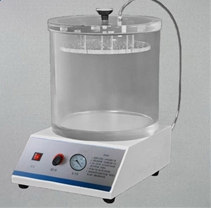The principle of detecting the tightness of pharmaceutical packaging bags
The principle of detection of the sealing of pharmaceutical packaging bags:
By the vacuum chamber is evacuated, so that the sample is immersed in water in the generated external pressure, observations in the case where the sample gas to escape, in order to determine the sealing properties of the specimen; chamber is evacuated by the vacuum, the sample is generated inside and outside The pressure difference is observed, and the shape of the sample is recovered after the sample is expanded and the vacuum is released, thereby determining the sealing performance of the sample.

Note:
Seal tester
Model MFY-1 (Economy)
Product use: MFY-1 seal tester is suitable for sealing test of packaging bags, bottles, tubes, cans, boxes, etc. in food, pharmaceutical, medical equipment, daily chemical, automotive, electronic components, stationery and other industries. It is also possible to test the sealing performance of the test piece after the drop and pressure test.
Features
1. It adopts manual control to maintain pressure, which is more convenient to operate and more stable in performance.
2. All pneumatic originals are made of well-known manufacturers, and the performance is stable and reliable. The pressure holding instability caused by pneumatic originals is eliminated.
3. High-quality plexiglass (acrylic) sealed barrel, the wall thickness is increased to 15mm, which effectively enhances the compressive strength of the sealed barrel and prolongs the service life.
4. Electronic pressure holding device reduces mechanical wear and makes the holding time last longer.
5. PVC operation panel, pressure pointer display, instant and accurate, convenient for users to quickly check the pressure value.
Test principle:
By the vacuum chamber is evacuated, so that the sample is immersed in water in the generated external pressure, observations in the case where the sample gas to escape, in order to determine the sealing properties of the specimen; chamber is evacuated by the vacuum, the sample is generated inside and outside The pressure difference is observed, and the shape of the sample is recovered after the sample is expanded and the vacuum is released, thereby determining the sealing performance of the sample.
Technical Parameters
1. Vacuum degree: -90kPa~0
2. Accuracy: Class 1
3. Effective size of vacuum chamber: Φ300mm×390mm (H) (standard)
Note: Other sizes can be customized.
4. Air source pressure: 0.7MPa (air source user-supplied)
5. Air source interface: Φ8 polyurethane tube
6. Dimensions: 460mm (L) × 360mm (B) × 530mm (H)
7. Power: AC 220V 50Hz
8. Net weight: 12kg
Standard configuration: host + experimental sealed barrel + air source line
According to the standard: GB/T 15171 , ASTM D3078
More information!
Jinan Jingji Testing Instrument Co., Ltd.
Everything You Need To Know About LED Lighting
LEDs are a simple invention with huge potential to change the lighting industry for the better. Don`t know much about them? Here are three big things you need to know to get your feet under you:
1.What Does LED Stand For?
2.LED stands for light-emitting diode.
A diode is an electrical device or component with two electrodes (an anode and a cathode) through which electricity flows - characteristically in only one direction (in through the anode and out through the cathode). Diodes are generally made from semi-conductive materials such as silicon or selenium - substances that conduct electricity in some circumstances and not in others (e.g. at certain voltages, current levels, or light intensities).
2.A light-emitting diode is a semiconductor device that emits visible light when an electrical current passes through it. It is essentially the opposite of a photo-voltaic cell (a device that converts visible light into electrical current).
Did You Know? There is a similar device to an LED called an IRED (Infrared Emitting Diode). Instead of visible light, IRED devices emit IR energy when electrical current is run through them.
1.How Do LED Lights Work?
2.It`s really simple actually, and very cheap to produce, which is why there was so much excitement when LED lights were first invented!
The p-type and n-type materials are created by introducing the original material to atoms of another element. These new atoms replace some of the previously existing atoms and in so doing, alter the physical and chemical structure. The p-type materials are created using elements (such as boron) that have less valence electrons than the intrinsic material (oftentimes silicon). The n-type materials are created using elements (such as phosphorus) that have more valence electrons that the intrinsic material (oftentimes silicon). The net effect is the creation of a p-n junction with interesting and useful properties for electronic applications. What those properties are exactly depends mostly on the external voltage applied to the circuit (if any) and the direction of current (i.e. which side, the p-type or the n-type, is connected to the positive terminal and which is connected to the negative terminal).
Application of the Technical Details to LED Lighting:
When a light-emitting diode (LED) has a voltage source connected with the positive side on the anode and the negative side on the cathode, current will flow (and light will be emitted, a condition known as forward bias). If the positive and negative ends of the voltage source were inversely connected (positive to the cathode and negative to the anode), current would not flow (a condition known as reverse bias). Forward bias allows current to flow through the LED and in so doing, emits light. Reverse bias prevents current from flowing through the LED (at least up until a certain point where it is unable to keep the current at bay - known as the peak inverse voltage - a point that if reached, will irreversibly damage the device).
LED panel light,LED tube, led high bay light,led industry light
Guangzhou Zhongzhinan Supply Chain Co.,Ltd. , https://www.gzzhongzhinan.com